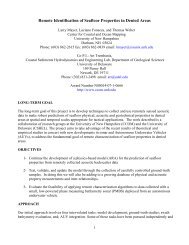EM 2040 Multibeam echo sounder
EM 2040 Multibeam echo sounder
EM 2040 Multibeam echo sounder
You also want an ePaper? Increase the reach of your titles
YUMPU automatically turns print PDFs into web optimized ePapers that Google loves.
<strong>EM</strong> <strong>2040</strong><br />
<strong>Multibeam</strong> <strong>echo</strong> <strong>sounder</strong><br />
True wide band high resolution<br />
multibeam <strong>echo</strong> <strong>sounder</strong>
<strong>EM</strong> <strong>2040</strong><br />
Key facts<br />
The <strong>EM</strong> <strong>2040</strong> multibeam <strong>echo</strong><br />
<strong>sounder</strong> is the first system to bring<br />
all the advanced features of deep<br />
water multibeams to the near bottom<br />
sounding environment. Important<br />
deep water system features included<br />
with the <strong>EM</strong> <strong>2040</strong> are:<br />
• Dual swath per ping to allow a<br />
doubling of survey speed<br />
• FM chirp to achieve a much longer<br />
range capability<br />
• Complete roll, pitch and yaw<br />
stabilization<br />
• Nearfield focusing both on<br />
transmit and receive<br />
The <strong>EM</strong> <strong>2040</strong> is modular, allowing<br />
the user to tailor the beamwidths to<br />
the operational requirements, 0.5 by<br />
1 and 1 by 1 degrees. The transmit<br />
fan is divided into three sectors<br />
pinging simultaneously at separate<br />
frequencies. This ensures a very<br />
strong and beneficial dampening<br />
of multibounce interference which<br />
on simpler systems often is seen at<br />
beam angles from 60 degrees and<br />
outwards. The <strong>EM</strong> <strong>2040</strong> has dual<br />
swath capability, allowing a sufficient<br />
sounding density alongtrack at a<br />
reasonable vessel speed, for example<br />
8 knots achieving 100% coverage<br />
with a 0.5 degree transmit fan.<br />
The operating bandwidth available<br />
on the <strong>EM</strong> <strong>2040</strong> is unprecedented,<br />
from 200 to 400 kHz, which is a<br />
full octave, and this is achieved<br />
with the standard transducers. The<br />
operator can thus on the fly choose<br />
the best operating frequency for<br />
the application, 300 kHz for near<br />
bottom, 200 kHz for deeper waters,<br />
and 400 kHz for very high resolution<br />
inspection.<br />
The bandwidth of the <strong>EM</strong> <strong>2040</strong><br />
transducers allows the system to<br />
effectively operate with very short<br />
pulse lengths, i.e. down to 25<br />
microseconds. With 25 microseconds<br />
pulse length the raw range resolution<br />
(cτ/2) will be less than 20 mm.<br />
The <strong>EM</strong> <strong>2040</strong> is well suited for<br />
surveys meeting the IHO-S44 special<br />
order.<br />
The standard depth rating of the<br />
<strong>EM</strong> <strong>2040</strong> subsea parts is 6000 m.<br />
The system is thus fully prepared<br />
for operation on subsea vehicles<br />
such as AUVs or ROVs. All analog<br />
electronics are contained in the<br />
transducers, and communication to the<br />
topside Processing Unit is on standard<br />
Ethernet. For subsea vehicle use the<br />
Processing Unit may be mounted in a<br />
pressure vessel with an inner diameter<br />
as small as 230 mm.<br />
Components<br />
The basic <strong>EM</strong> <strong>2040</strong> has four<br />
units, a transmit transducer, a receive<br />
transducer, a processing unit, and a<br />
workstation. For completeness, data<br />
input from a motion sensor and a<br />
positioning system is required, as is<br />
the sound speed profile of the water<br />
column between the transducers<br />
and the bottom. Sound speed at the<br />
transducer is an optional input.<br />
The <strong>EM</strong> <strong>2040</strong> is delivered with a<br />
mounting plate with factory aligned<br />
guidances. It is recommended that<br />
the mounting plate is built into a steel<br />
casing and protected by a baffle for<br />
multipath reduction. Optionally, the<br />
transducers may be delivered mounted<br />
on a frame together with the motion<br />
sensor and a sound speed sensor,<br />
factory aligned for ease of mounting.<br />
The <strong>EM</strong> <strong>2040</strong> is a modular system,<br />
fully prepared for upgrading to cater<br />
for more demanding applications. The<br />
transmit transducer has an angular<br />
coverage of 200º (±100º) as standard,<br />
allowing a coverage of 5.5 times<br />
water depth when matched with a<br />
single receive transducer. Adding<br />
a second receive transducer allows<br />
surveying to the water surface or up to<br />
10 times water depth on flat bottoms.<br />
The transducers are separate units<br />
with titanium housings.<br />
The transducers are interfaced to<br />
a processing unit via Ethernet, 100<br />
Megabit/s to the transmit transducer<br />
and Gigabit from the receive
<strong>EM</strong> <strong>2040</strong><br />
transducer. The Processing Unit also<br />
supplies power to the transducers.<br />
Operator control, data quality<br />
inspection and data storage is handled<br />
by the hydrographic workstation<br />
running the same SIS software as all<br />
other Kongsberg multibeams.<br />
Operational modes<br />
The <strong>EM</strong> <strong>2040</strong> has a frequency<br />
range of 200-400 kHz. Three<br />
standard modes are available. 300<br />
kHz is used for normal operation,<br />
giving an optimum balance between<br />
high resolution, depth capability<br />
and tolerance of detrimental factors<br />
such as water column sediments.<br />
200 kHz is available for meeting<br />
requirements to operate at the<br />
standard hydrographic single beam<br />
Advanced functions<br />
• Frequency range: 200 to 400 kHz<br />
frequency, but also to achieve the best<br />
depth capability. 400 kHz is provided<br />
for inspection work with the utmost<br />
resolution.<br />
The normally recommended<br />
survey frequency is 300 kHz. At this<br />
frequency the bandwidth used is more<br />
than 75 kHz with three angular sectors<br />
which are run at separate frequencies.<br />
With dual swath six separate<br />
frequencies are used. The minimum<br />
pulselength is 35 microseconds. The<br />
range resolution is then 26 mm. For<br />
deep waters FM chirp is employed<br />
with a bandwidth of 1.7 kHz. This<br />
allows a swath width in the order of<br />
550 m and a depth capability of about<br />
350 m in cold ocean waters.<br />
The 200 kHz frequency mode<br />
has the same CW pulselengths as<br />
the 300 kHz mode. The FM chirp<br />
pulselength is extended compared<br />
to the 300 kHz mode. Normally two<br />
sectors are used per swath. At this<br />
frequency the absorption in the water<br />
is lower than at 300 kHz, resulting<br />
in increased swath width and depth<br />
capability. In cold ocean waters with<br />
FM chirp a swath width of 700 m can<br />
be expected, and approximately 500<br />
m depth capability achieved.<br />
The 400 kHz frequency mode is<br />
intended for high resolution inspection<br />
work. Very short transmit pulses and<br />
wide receiver bandwidth is used. The<br />
operator may choose between one and<br />
three transmit sectors. With a single<br />
RX transducer the coverage can be<br />
up to 120º (±60º), and with dual RX<br />
the coverage can be up to 180º (±90º).<br />
The shortest pulse used is 25 µs. It is<br />
also possible to run dual swath, but<br />
not with the shortest pulse length.<br />
• Dual swath capability, allowing a sufficient sounding density alongtrack<br />
at a reasonable survey speed<br />
• FM chirp allowing much longer range capability<br />
• Complete roll, pitch and yaw stabilization<br />
• Nearfield focusing on both transmit and receive<br />
• Operates with very short pulse lengths, down to 25 microseconds<br />
• The depth rating of the subsea parts is 6000 m<br />
Transducer array (Rx/Tx)<br />
Monitor<br />
HydrographicWork Station (HWS)<br />
Processing Unit (PU)
Technical specifications*<br />
• Frequency range: 200 to 400 kHz<br />
• Max ping rate: 50 Hz<br />
• Swath coverage sector: Up to 140º<br />
(±70º) (single RX) / 200 º (±100º)<br />
(dual RX)<br />
• Sounding patterns:<br />
Equiangular, Equidistant and High<br />
Density<br />
• Roll stabilized beams: Yes, +/-15°<br />
• Pitch stabilized beams: Yes, +/-10°<br />
• Yaw stabilized beams: Yes, +/-10°<br />
0.5 x 1 degrees ** Max depth Max coverage<br />
Operating frequency Cold ocean Fresh water Cold ocean Fresh water<br />
200 kHz 500 m 1070 m 740 m 1520 m<br />
300 kHz 370 m 590 m 580 m 920 m<br />
400 kHz 200 m 270 m 310 m 420 m<br />
1 x 1 degrees ** Max depth Max coverage<br />
Operating frequency Cold ocean Fresh water Cold ocean Fresh water<br />
200 kHz 470 m 1000 m 700 m 1410 m<br />
300 kHz 360 m 560 m 550 m 860 m<br />
400 kHz 180 m 250 m 290 m 390 m<br />
Pulse lengths 200 kHz 300 kHz 400 kHz<br />
CW FM CW FM CW FM<br />
Normal mode 70, 200 and 600 µs 12 ms 70, 200 and 600 µs 6 ms 50 and 100 µs N/A<br />
Single sector mode 35, 70 and 150 µs 1.5 ms 35, 70 and 150 µs 1.5 ms 25 and 50 µs N/A<br />
Max no. of soundings per ping (dual swath) 200 kHz 300 kHz 400 kHz<br />
Single RX 1° RX 800 800 800<br />
Dual RX 1° RX 1600 1600 1600<br />
Physical dimensions (excluding connectors and mounting arrangements)<br />
200 kHz 300 kHz 400 kHz Dimensions Weight<br />
Tx 0.75° 0.5° 0.4° 727 x 150 x 142 mm (L x H x W) 45 kg<br />
Tx 1.5° 1° 0.75° 407 x 150 x 142 mm (L x H x W) 24 kg<br />
Rx 1.5° 1° 0.75° 407 x 136 x 142 mm (L x H x W) 23 kg<br />
Processing Unit (4U 19” rack)*** 447 x 178 x 345 mm (W x H x D) 15 kg<br />
Hydrographic Work Station (4U 19” rack) 427 x 178 x 480 mm (W x H x D) 20 kg<br />
19” Monitor 483 x 444 x 68 mm (W x H x D) 12 kg<br />
* Preliminary specifications. All options may initially not be available<br />
** Beamwidths applicable to 300 kHz<br />
*** More than one Processing Unit may be necessary<br />
Kongsberg Maritime is engaged in continuous development of its products, and reserves the right to alter the<br />
specifications without further notice.<br />
332644 / Rev.F / March 2011<br />
Kongsberg Maritime AS<br />
Strandpromenaden 50<br />
P.O.Box 111<br />
N-3191 Horten,<br />
Norway<br />
Telephone: +47 33023800<br />
Telefax: +47 33044753<br />
www.kongsberg.com<br />
subsea@kongsberg.com


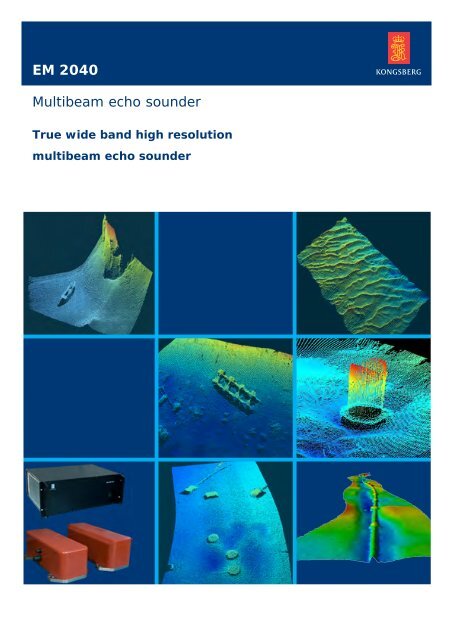
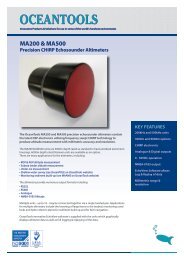

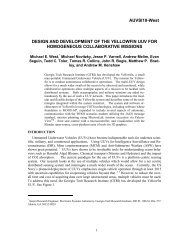
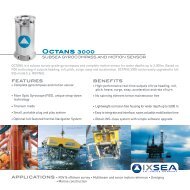
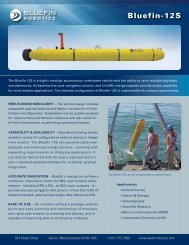
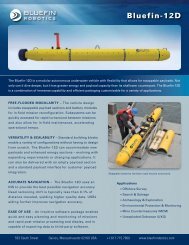


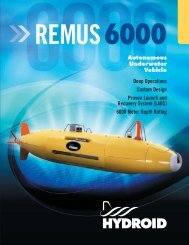


![Sonardyne Wideband Sub-Mini 6 [8270, 8271].pdf - AUVAC](https://img.yumpu.com/44408971/1/190x245/sonardyne-wideband-sub-mini-6-8270-8271pdf-auvac.jpg?quality=85)


